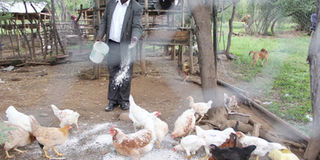Breaking News: KDF chopper crash kills five
Poultry farmers left behind

Andrew Rumenya, 53, feeds his poultry in the semi-arid Kerio Valley on September 16, 2013. Photo/JARED NYATAYA
What you need to know:
- The birds were provided with little or no supplementary feeds.
- This made the birds susceptible to nutrient deficiencies and they thus suffered from high mortality rate occasioned by the nutrient deficiencies.
- The system is practised to date. In the rural setting, farmers hardly sell or slaughter their chicken.
As at 2008, Kenya had an estimated poultry population of 29 million birds.
Majority of these were free ranging chicken that are common in most rural areas. In the free range system, the chickens are allowed to scavenge at daytime and housed at night.
In rural poor households, poultry remains the most important enterprise that affords the lot nutrition and food security. Such households mostly concentrate on the free range system of poultry rearing.
Traditionally, Kenyan farmers practised this kind of poultry rearing system. The birds were provided with little or no supplementary feeds.
This made the birds susceptible to nutrient deficiencies. They thus suffered from high mortality rate occasioned by the nutrient deficiencies as well as predators such as eagles.
The system is practised to date. In the rural setting, farmers hardly sell or slaughter their chicken.
Slaughtering is only done during festivals when there are guests in the household. Another down side of the traditional poultry keeping is that a lot of eggs are lost.
Free ranging chicken comprised 68 percent of the 2008 estimated poultry population of 29 million birds.
Apart from chicken, other poultry species like ducks, turkeys, pigeons, ostriches, guinea fowls and quails are reared in Kenya.
TOWNSHIPS
Over the years, the indigenous poultry industry in Kenya has seen tremendous growth due to the high demand for its products, especially in townships.
According to the Ministry of Livestock Development session paper of November 2008, the annual poultry meat production stood at 20,000 metric tones.
Despite some challenges faced in the rearing of indigenous chicken, they are more preferred than the commercial breeds.
The commercial breeds otherwise known as the broilers are raised in confined conditions where disease outbreak can be managed through sterilisation.
Farmers raising the broilers are compelled to purchase expensive feeds rather than relying on nature’s abundant feeds like insects and worms.
While the hybrid chicken can mature within six weeks, the high start-up capital is what discourages most individuals venturing into the business.
The demand for poultry meat regardless of it being hybrid or indigenous has always been on an upward trend.
While this can partly be linked to an increase in the cost of red meat, it is also attributable to the growing number of consumers who are health conscious.
Eggs and meet are considered complete sources of protein as they not only contain all the essential amino acids needed for humans but also important fats, vitamins and minerals.
Poultry rearing has in the recent past transformed into a lucrative business venture such that there emerged a breed of brokers who are keen to share in the profits farmers are meant to enjoy.
Farmers have had to adapt to changing environment of doing business in order to stay profitable despite a rise in the cost of producing broilers and layers.
In the past two years, there has been a shoot up in the prices of poultry feeds such as layers mash. A 70Kg bag currently sells at Sh3,150 up from Sh1,900 in 2010.
The high cost of feeds meant hiked egg prices. This forced some egg traders to cross the border to Uganda where they could buy cheaper eggs and re-sell them at higher prices in Kenya. The phenomenon left Kenyan farmers suffering from unsold eggs.
In the North Rift, farmers switched to producing Kenbro, a dual purpose improved indigenous breed of chicken that is cheaper to maintain and has higher earnings.
Kenbro, which belongs to Kenchic, was developed by a French company.
According to the farmers, its eggs are in high demand with one selling at Sh30 compared to Sh15 for those from indigenous breeds and Sh12 for exotic breeds.
The bird according to experts can be managed to produce eggs or meat depending on what the farmer wants.
Humphrey Mbugua, a technical advisor at Kenya Poultry Breeders Association notes that Kenbro is a hardy breed, compared to hybrid chicken and can be farmed free-range like the indigenous birds.
He says depending on what the farmer wants, the bird can be managed to produce eggs or meat.
“When managed as a broiler with commercial feeds, it can achieve 1.5 kg in seven weeks, or after three weeks of brooding it can be managed on free range with minimal supplementary feeding and be ready for consumption or sale after 10 to 14 weeks,” says Dr Mbugua.
While there emerging modern poultry farming methods, farmers seem eternally attached to rearing indigenous breeds.
It appears the indigenous poultry industry has a recognized potential to generate higher income and transform living standards if appropriate interventions are developed and implemented.
The Kenya Economic Report (Kippra) identifies poultry as one of the leading livestock enterprises that can contribute the most towards the attainment of the UN’s Millennium Development Goal 1.



